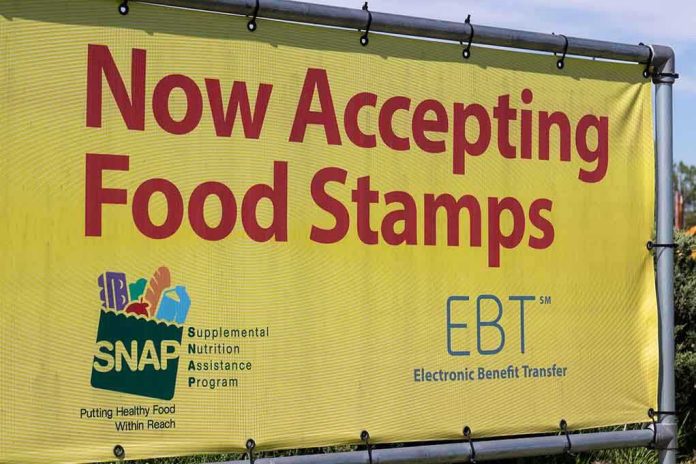
The fate of 41 million Americans’ next meal now hangs in the balance, as political brinkmanship in Congress threatens to yank food benefits just as the new fiscal year begins.
Story Snapshot
- October SNAP benefits are assured, but November and beyond are at risk if the shutdown drags on
- Food assistance for 41 million hinges on congressional action before federal funding lapses
- Food banks brace for an overwhelming surge if benefits are disrupted
- This standoff revives painful memories of the 2019 shutdown, but with even higher stakes
Congressional Deadlock Pushes Millions Toward the Brink
Federal budget gridlock has become an all-too-familiar American spectacle, but this year’s standoff carries a particularly cruel edge. As the clock ticks past September 30, 2025, Congress’s failure to fund the government means the Supplemental Nutrition Assistance Program—lifeline for one in eight Americans—faces imminent disruption. The October benefits, pre-loaded thanks to contingency planning, offer a thin cushion. But November looms like a cliff, and if lawmakers don’t act, the monthly food budgets of 41 million will evaporate overnight.
The scale is staggering. SNAP has roots going back to the 1960s, designed as a federal promise against hunger. But in 2025, that promise is collateral damage in a fiscal standoff. State agencies, responsible for distributing EBT benefits, scramble to answer anxious calls, while food banks brace for a surge reminiscent of the darkest pandemic days. The sense of déjà vu is strong: during the 2019 shutdown, similar uncertainty left families and grocers in limbo. This time, the stakes are higher, the planning better, but the outcome just as uncertain.
How a Shutdown Threatens the Nation’s Food Security
Congress’s budget impasse triggers the Antideficiency Act, forcing all programs dependent on annual appropriations—including SNAP, WIC, and school nutrition programs—to halt new spending. The USDA, which oversees these benefits, has not unveiled a new contingency plan for 2025, relying instead on last-minute obligations to secure October benefits. That buffer, however, is razor-thin. If the shutdown continues, November benefits will not be funded, leaving state agencies with empty coffers and recipients with empty pantries.
The impact radiates far beyond government offices. Food retailers, many in rural and urban food deserts, rely on SNAP spending to stay afloat. A lapse would hit local economies hardest, reducing grocery sales and threatening jobs. Food banks, already stretched by inflation and lingering pandemic demand, warn they will be unable to fill the gap if millions lose their monthly food assistance. Advocacy groups describe the scenario as a “perfect storm,” where bureaucratic paralysis translates into real hunger and hardship.
Stakeholders, Scrambling Against the Clock
On Capitol Hill, appropriations committees and party leaders hold the keys to a resolution, but negotiations remain mired in partisan standoffs. USDA officials and state human services directors work overtime to communicate contingency plans to the public, but their hands are tied by the limits of federal funding. SNAP recipients—families, seniors, disabled Americans—watch the news and check their EBT balances, caught in the crossfire of a fight they cannot influence.
Food banks and charities, the nation’s unofficial emergency food system, gear up for a tidal wave of need. Their experience in 2019 and during COVID-19 revealed the limits of private charity to replace federal aid. This year, with food prices still high and donations lagging, their leaders warn of rationing and long lines if the shutdown outlasts the October buffer. Meanwhile, advocacy organizations launch urgent campaigns, warning that the consequences of inaction will be measured in empty stomachs and crowded food pantries.
Consequences That Ripple Far Beyond Washington
The short-term outcome is clear: if Congress fails to act, November SNAP and WIC benefits will not be issued. The longer-term fallout is less predictable but no less dire. Food insecurity will spike, especially among children, seniors, and people with disabilities. Local economies dependent on SNAP dollars will feel the pinch, as will grocers, truckers, and food suppliers. The political consequences are already percolating, with lawmakers facing constituent outrage and headlines that cut through partisan spin.
Experts stress that this is not merely a bureaucratic technicality. The very act of turning off SNAP, even briefly, is a test of America’s social contract. Economists warn of a ripple effect: less spending at local stores, more families in crisis, and a loss of public trust in the safety net. Some policymakers call for reforms to insulate SNAP from future shutdowns, warning that annual brinkmanship undermines both program stability and public faith. For now, the nation waits as a divided Congress holds the fate of 41 million at stake—one more meal, one more month, one more deadline away from disaster.
Sources:
Food Research & Action Center (FRAC) blog, September 27, 2025







